|
|
|
|
|
|
|
Achi-Kochi Japan
Showing many places to visit and foods to eat in Japan
|
|
|
|
|
|
|
|
|
|
|
|
|
Japan
> Tokyo region
> Kokyo
|
|
|
|
|
|
|
Kokyo
The Imperial Palace, Tokyo ( Achi-Kochi Japan )
|
|
|
|
|
|
|
|
|
|
|
|
|
( "Achi-Kochi" in Japanese means "Here and there" in English. )
Kokyo, the Imperial Palace and Edo-jo castle
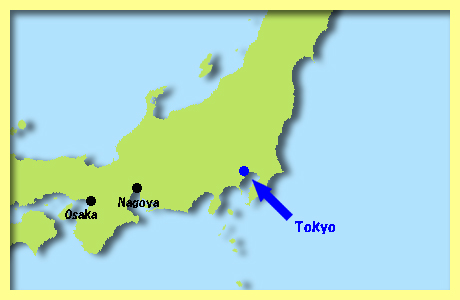
Tokyo is the center of Japan and one of the biggest cities in the world. However it had been a small castle town called "Edo" when Edo-jo ( castle ) was built in A.D.1457 by Dokan Ota, a samurai warrior. The castle was strengthened and enlarged in the 17th century by the Tokugawa Shogunate, established by Ieyasu Tokugawa in Edo. Since then on, Edo had developed rapidly.
|
|
Kokyo, the Imperial Palace

Ieyasu Tokugawa moved to "Edo" in A.D.1590 and established Tokugawa Shogunate there in A.D.1603. However in A.D.1868 Tokugawa Shogunate was overthrown and Edo was renamed "Tokyo" by Meiji Government while Edo-jo Castle became "Kokyo" ( the Imperial Palace - above ).
Access to most of the important structures of Kokyo is strictly limited. However some parts of Kokyo and some areas in the site of Edo-jo ( castle ) are open to the public. There are many historic sites while the gardens and forests are rich in nature.
|
|
Tenshu
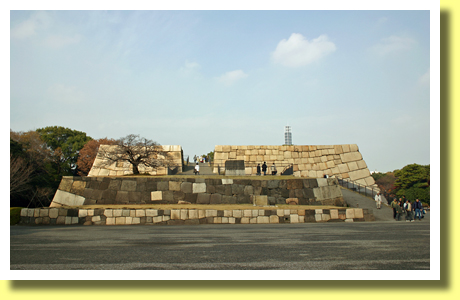
When Ieyasu Tokugawa moved to Edo in A.D.1590, he enlarged old Edo-jo castle. After he established Tokugawa Shogunate, he strengthened the castle further and built a huge Tenshu ( main keep ). His son, Hidetada and his grandson, Iemitsu rebuilt their own Tenshu. However the Tenshu was destroyed in the fire in A.D.1657. The reconstruction planned, had not started. So the foundation of the Tenshu remains as above.
It is said that the five-storey Tenshu, built by Iemitsu Tokugawa, was 51 meters in height, the highest in Japan at the time. Iemitsu Tokugawa, a grandson of Ieyasu, the 3rd shogun was a person who enlarged Nikko Toshogu ( shrine ), which had been built by Hidetada, the 2nd shogun to enshrine Ieyasu, the 1st shogun.
|
|
Fujimi-yagura
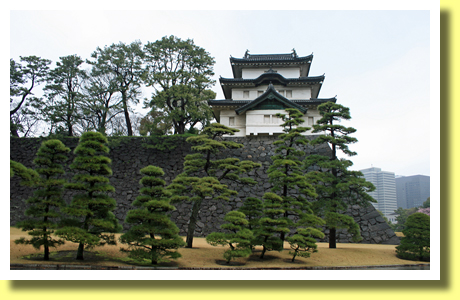
The main keep of the castle was destroyed in A.D.1657 and the reconstruction was not carried out. So Fujimi-yagura ( above ) , three storey keep built in A.D.1659, served a function of the main keep.
Though access to Fujimi-yagura is not allowed, Fuji mountain can be seen from it. "Fujimi" in Japanese means "seeing Fuji mountain" while "yagura" does "keep". So the keep was named "Fujimi-yagura". In Edo-jo Castle. there used to be dozens of keeps, among which surviving are three including Fujimi-yagura.
|
|
Moats and Keeps

Moats surrounded Edo-jo Castle while keeps strengthened the defense such as Tatsumi-yagura ( or Sakurada-yagura - above ). Tatsumi-yagura is one of the keeps surviving through a few centuries as well as Fujimi-yagura is.
|
|
Ote-mon ( gate )
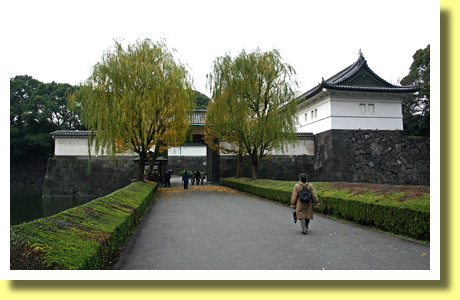
Edo-jo Castle was strengthened with more than a hundred of gates such as Ote-mon ( above ), which was the main gate of the castle. In A.D.1657 the gate was destroyed in the fire and reconstructed next year. The gate was damaged by earthquakes in A.D.1923 following A.D.1703 and A.D.1855 and it was repaired and rebuilt.
|
|
Bansho ( Guard Stations )
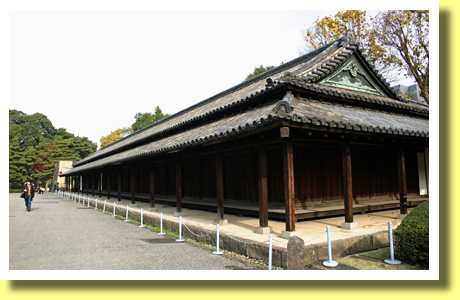
Inside the castle near gates, there were many bansho ( guard stations ) such as Hyakunin-Bansho ( above ), which housed more than a hundred guardsmen. "Hyakunin" in Japanese means "a hundred people" while "bansho" does "guard station".
Among hundreds soldiers who stationed in Hyakunin-Bansho, there were dozens of descendants of Ninja employed by Ieyasu Tokugawa.
|
|
Plum Blossoms

The above photo, taken at Bairin-zaka in Kokyo in early February, shows plum blossoms in the snow. It is said that Dokan Ota, who built Edo-jo Castle, founded a shrine in the castle and planted hundreds of plum trees around the shrine in A.D.1478. It is also said that Bairin-zaka is a site of the shrine. "Bairin" in Japanese means "forest of plum trees" while "zaka" does "slope".
|
|
Ninomaru Garden
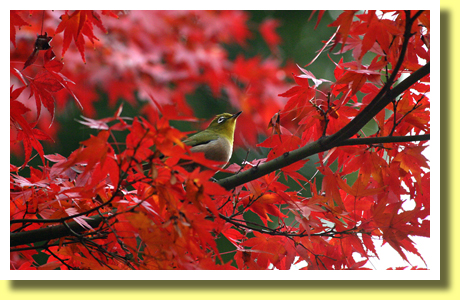
In Kokyo, the Ninomaru Garden is entertaining the visitors. A forest of various trees in the garden shows colors of the seasons such as autumn leaves ( above ).
|
|
Sakura ( Cherry Blossoms )

Along the moats surrounding Kokyo, Edo-jo Castle, there are lots of Sakura trees. So many people walk along the moats to see Sakura ( Cherry Blossoms ) in spring.
|
|
Guided Tour
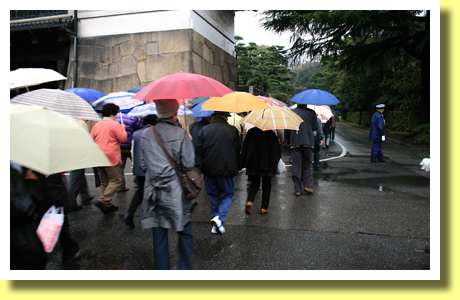
Though access to most of the important structures of Kokyo is strictly limited, visitors could join guided tours under a certain conditions to go deeper into Kokyo ( The Imperial Palace ) as above.
For further details ==>
The Imperial Household Agency
|
Copyright (c) 2021 Achi-Kochi Zanmai Co., Ltd.
|